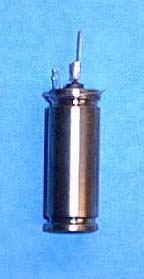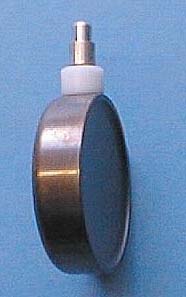Introduction
Software
Applications
Detectors
GM-10
GM-45
GM-90
Accessories
Test Source
Battery Box
Coincidence Box
Anti-Coincidence
GMI Interface
Air Sampler
Download
Linux
Users Group
Interfacing
Raspberry Pi
Random Numbers
Safety Uses
Radiation Info
Specifications
FAQ
Articles
Experiments
Rad Map
Links
Secure Order
Detectors
Contact
Geiger Counter
Geiger counters are devices to detect and measure ionizing (nuclear) radiation. They are one of the oldest devices used to for this purpose, but are still one of the most sensitive, especially for the low radiation levels typically found in most situations.
The typical geiger counter consists of a metal body, called the tube, which is filled with gas at a low pressure. The gas usually contains Argon and Neon, along with small quantities of other gases (the quenching agent described below).
There is a second metal conductor, which is usually in the form of a thin wire, which runs inside the tube to a connector on the tube body. A high voltage, typically 500 or so volts, is applied between this conductor and the geiger counter tube body.
When a charged particle, such as an alpha or beta ray, or a gamma ray or x-ray, enters the geiger counter tube, it can hit one or more of the gas atoms, knocking off electrons. This process is called ionization.
The ionized gas is able to conduct electricity. In the case of the geiger counter, the applied voltage is high enough so that as the electric current flows, the electrons cause additional atoms to be ionized, resulting in even more current flow. In a very short amount of time, the feeble current caused by the radiation particle has grown to a larger current, which is easier to measure.
The quenching agent gas in the geiger counter stops the flow of electrical current after a few microseconds. Older geiger tubes used gases such as methane, which broke down each time there was a detection, resulting in a finite lifetime for the tube. Modern geiger counter tubes use gases that don't break down, resulting in essentially an unlimited lifetime for the tube, providing it is operated within the specifications and not subjected to physical abuse.
Each gas discharge event is measured and counted. Often, the number of events or counts per minute is recorded, resulting in the typical Counts Per Minute or CPM reading so often seen. Some detectors produce a click each time an event is detected. The higher the clicking rate, the higher the radiation level.
As weaker types of radiation are often not able to pass through the metal body of the geiger counter tube, often a thin window of light weight material is provided. The mineral mica is often used. Very weak radiation, even alpha rays, can pass though mica. The mica is of course more fragile than the metal, and must be protected from damage. Even just touching a mica window can cause permanent damage to the tube, as the window will usually immediately burst.


The geiger counter tube on the left is an end window tube, the one on the right is a pancake tube, with a much large mica window, giving much better sensitivity to alpha and beta radiation.
Geiger counter based radiation detectors have many advantages over other detectors, which typically use ionization chambers. They can detect very low levels of radiation - a single particle can be detected. Ionization chambers are only suitable for measuring large levels of radiation, a single particle of radiation cannot be detected. Geiger counters are also typically much smaller, as ionization chambers need to be quite large, due to their low efficiency in detecting radiation.
Black Cat Systems offers a wide range of radiation detectors that use geiger counter tubes as the radiation sensor. The major difference between the various models is the sensitivity - the more sensitive units are capable of detecting smaller amounts of radaition. Most of our detectors can detect all three types of radiation - alpha, beta, and gamma / x-ray. We also offer detectors that are designed primarily for gamma / x-ray detection only.
We have a comparison of our geiger counter based radiation detectors available.